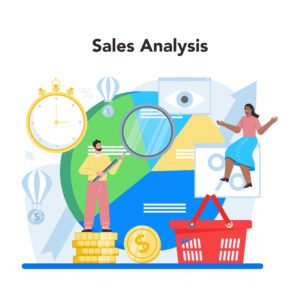E-commerce SEO is the process of optimising your online store’s website to improve its visibility and ranking on search engines like Google. By implementing various SEO strategies such as on-page/off-page SEO, you can increase organic traffic to your site and ultimately drive more sales.
In this comprehensive guide, we’ll cover everything you need to know about e-commerce SEO and how you can apply it to your online business.

Why is it crucial to have a high ranking for your e-commerce business?
If you want to bring more traffic to your store you will need to optimise your e-commerce website so that it can rank on Google’s top page:
Why? Simply because the top-ranking page gets the most search traffic only 49% of the time. (Ahrefs)
Read on to find out all the strategies to optimise your E-commerce SEO.
1. On-Page Optimisation
On-Page Optimisation is all about making sure your website and webpages are properly optimised for search engine crawlers by improving the technical structure and content of your website.
Keyword Research
Conducting keyword research using various tools like Google Keyword Planner or Ahrefs can help you identify the most relevant and profitable keywords to target for your online store.
Tip: Focus on commercial-intent keywords as your goal as an e-commerce business is to sell.
Vary your keyword Strategy
It’s also relevant to add some long-tail keywords and LSI (Latent Semantic Indexing) keywords alongside your primary keyword.
These are words/phrases related to the main topic. It helps search engines better understand the context of your content and will likely improve rankings.
Product Page Optimisation

As Neil Patel once mentioned, it’s important to “create content that teaches. You can’t give up. You Need to be consistently awesome”.
Keeping this in mind, apply it to your e-commerce business and thoroughly inform your customers about the key features/benefits of your products and services. Use relevant keywords in your product titles, descriptions, and image alt text.
Moreover, product reviews are equally as important. Product reviews are essential for e-commerce businesses as they provide valuable information to potential customers, build trust, and improve search engine ranking. Google recognises the value of high-quality product reviews and rewards websites that prioritize them with better search rankings.
Perhaps, throw a bit of social proofing and customer reviews in too so you gain more credibility and conversions.
URL Structure
Optimising your URL structure involves creating clean and descriptive URLs that include relevant keywords and are easy to read and understand.
Pro Tip: Don’t go over the 60-character limit.
Site Architecture

Optimising your site architecture involves creating a clear and logical hierarchy of pages and categories that make it easy for users and search engines to navigate your site.
Aleyda Solis of Orainti, shares her top e-commerce SEO tip, which is all about site structure:
“Use the supply and demand principle to identify which levels of the website structure—from categories to attributes, brands or filters listing pages—are worthy to index and optimise for, as they fulfil an actual audience demand.”
Breadcrumbs are also a type of navigational element that helps users find their way around a website more easily. By outlining the page hierarchy visually, breadcrumbs provide both context and an easy way for users to navigate back up through the structure of the site, ultimately improving their overall user experience.
Bonus tip: In addition, it may be good to add a canonical URL to tell google that the URL is the “master version” you’d like to display in search results. This is particularly useful when dealing with URLs that have changed or been replaced with updated versions.
If you don’t know what problems your site is having, why not let us do a full SEO audit for you? We’ll be able to identify any issues you may be facing and find solutions.
Internal Linking
Internal linking refers to the practice of including links to other pages on your website within your content and product pages.
This not only improves your website’s search engine optimisation (SEO), but also allows you to guide your customers through their buying journey. By linking to different landing pages, you can help your audience explore and learn more about your products.
Mobile Optimisation
It is essential to optimise your website for mobile devices if you want to improve your e-commerce SEO. This involves creating a responsive design that can adapt to various screen sizes, ultimately enhancing the overall user experience.
2. Off-Page Optimisation
Off-page optimisation involves optimising various elements of your online presence that is not directly related to your website. This includes link building, social media, influencer marketing, brand mentions, and local SEO.
Link Building
Link building involves acquiring high-quality backlinks to your website from other reputable websites. This can help to improve your search engine rankings and increase the visibility and credibility of your online store.
You can run a competitor keyword analysis and analyse backlinks on Ahrefs to find relevant sites in your niche.
Social Media
Social media can also be a powerful tool for e-commerce SEO. By creating engaging and informative social media content, you can increase brand awareness and drive more traffic to your site.

Influencer Marketing
Influencer marketing involves partnering with influencers in your industry to promote your products and increase brand awareness.
Brand Mentions
Brand mentions involve getting other websites and publications to mention and link to your brand.
3. Technical SEO
Technical SEO involves optimising the technical aspects of a website to improve its search engine ranking and visibility.
Site speed
According to Shopify, Site speed is key to e-commerce success.
Google considers site speed as a crucial factor in determining a website’s search ranking. In fact, Google announced that it had begin using page experience, which includes site speed, as a desktop search ranking signal since February 2022. So start optimising your Core web vitals or use tools like Google PageSpeed Insights to identify and fix issues that are slowing down your site.
Security
Site security is important for both user trust and search engine rankings. Use HTTPS encryption to secure your site, and regularly monitor for security issues.
Moreover, it is important to note that since e-commerce stores deal with financial transactions, you ought to provide information that assures users about the safety and security of their data.
Structured data
Structured data helps search engines understand the content on your site and can improve your visibility in search results. You can use tools like Google’s Structured Data Markup Helper to implement structured data on your site.
XML sitemaps
XML sitemaps provide search engines with a map of your site’s content, making it easier for them to crawl and index your pages. Start by utilising tools like Screaming Frog to create and submit XML sitemaps for your site.
Robots.txt
Robots.txt is a file that tells search engines which pages of your site to crawl and index, and which to ignore. Tools like Google’s Robots.txt Tester can ensure if your robots.txt file is properly configured.
Which KPIs to track on your E-commerce platform?
Conducting an analysis of your website’s performance is a critical component of search engine optimisation (SEO). Utilizing tools such as Google Analytics and Google Search Console enables you to assess and evaluate key performance indicators (KPIs) including traffic, rankings, conversion rates, e-commerce sales, bounce rates and various other metrics.
By continuously monitoring these KPIs, you will gain a better understanding of how your SEO endeavors are impacting your business. This valuable data can subsequently inform strategic adjustments and new initiatives aimed at optimising the effectiveness of your SEO campaigns.

Conversion rate optimisation
Conversion rate optimisation is the practice of improving the percentage of site visitors who take a desired action, such as making a purchase or filling out a form. Use techniques like A/B testing and user testing to optimise your site’s conversion rate.
Blogging
In order to publish high-quality blogposts on your E-commerce website, start by doing the following:
- Research what keywords to rank for. Publish content that targets keywords people are likely to search for when solving problems or making a buying decision.
- Present your products as a solution to the problem. Every post doesn’t have to be about your products. But, don’t be afraid to link out to a product page or two when appropriate.
User-Centered Design Principles
User-centred design (UCD) is a critical part of creating products and services that are successful and meet the needs of their intended users. By keeping the user at the centre throughout the entire design process, UCD emphasizes the importance of understanding user needs, wants, and behaviour to create an interface or product that is engaging, intuitive, easy to use, and effective. This approach helps ensure that your product or service meets all its intended requirements.
Check out the awesome example by ASOS. They are a leading clothing brand renowned for its exceptional website design. The site stands out with its bold colour palette, creative visuals, and cleverly-crafted title creating an overall enjoyable shopping experience.

Want more inspo for your site? Check it out here: https://netpeaksoftware.com/blog/top-12-examples-of-great-seo-ux-from-ecommerce-websites
How is UCD implemented?
One of the key components of UCD is usability testing, which involves gathering feedback from users throughout the design process.
This feedback helps designers identify areas of the product or service that may be confusing or frustrating for users, and make adjustments to improve the overall experience.
Persona development is also an essential part of UCD. By creating detailed profiles of typical users, designers can better understand their needs, motivations, and pain points, and tailor the design of their product or service to meet those needs.
For example, by using UCD principles to design a simple, intuitive checkout process, businesses can reduce cart abandonment rates and increase conversions. By incorporating user feedback into their product descriptions and images, businesses can ensure that customers have all the information they need to make informed purchasing decisions.

Outsourcing E-commerce SEO: Yes or No?
You can choose to handle SEO for your e-commerce business in-house or hire an agency or freelancer. Consider your budget, available resources, and expertise before making a decision.
SEO can be time-consuming and requires ongoing maintenance and updates. If you need help and don’t want the hassle of going through it, contact us to focus on your priorities.
Our team of experts has extensive experience in creating E-commerce SEO strategies that meet the specific requirements for success in Thailand. By understanding the local market, assessing user expectations, and utilizing effective SEO tactics, we strive to provide an enjoyable shopping experience for your customers. We customise our plans according to cultural nuances, language, user behavior metrics, and other pertinent factors.
Let us help you increase your visibility and attract customers in Thailand.